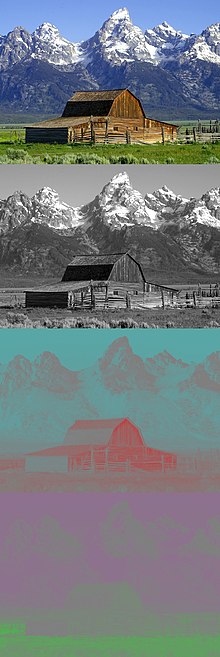YIQ color model
The YIQ color model is a color system with the luminance Y and the color differences I ( cyan - orange balance) and Q ( magenta - green balance). Compared to the related YUV color model , the color plane is rotated 33 ° clockwise.
The YIQ color space was used exclusively in the US standard for analog NTSC television. Since the YUV color model has also been preferred here since the 1970s, there is no longer any industrial application for the YIQ color model.
The motives for creating the YIQ color model as part of the development of color television are the same as for the YUV color model . However, the 33 ° rotation made it possible to transmit the individual color carriers with different bandwidths , I with 1.3 MHz and Q with 400 kHz. This takes better account of the human visual perception, because the human eye is more sensitive to color impressions on the I-line cyan-orange than on the Q-line magenta-green. In the YUV color model, the color components of these two lines are distributed unevenly over the two color signals U and V, so that no bandwidth reduction and thus no efficient transmission is possible.
The YIQ system is compatible with b / w ( black and white ) television, which only displays the Y signal, while color televisions display all three channels. The Y component has the largest share of the bandwidth of the television signal transmitted. This means that images from b / w televisions appear sharper than images from color televisions.
conversion
The conversion of linear R'G'B 'values in terms of luminous intensity (any existing gamma correction must therefore be reversed beforehand) to YIQ in matrix notation according to SMPTE standard 170M is:
To convert from Y'UV to Y'IQ, the components U and V are rotated counterclockwise by 33 ° and then swapped (U corresponds to the Q-axis). The combined rotation and transformation matrix results in:
Due to the symmetry of this matrix, it can also be used directly for the conversion back to Y'UV.
application
However, this color space has its raison d'etre in special areas. For example, when calculating the contrast of a font color on a colored background. With a light background, a dark font color should be used and vice versa. This cannot simply be done on the basic colors red , green and blue and their saturation, since the human eye has a different perception of brightness for different colors. For this reason, the arithmetic mean of the Y values for both the font and the background color is determined first. The subsequent subtraction of the two mean values can then be used as a reference to determine whether a font color can be recognized on the background. A large difference between the two mean values offers a good contrast and a small difference a poor contrast for legibility.
swell
- ^ Peter Henning: Pocket Book Multimedia . 4th edition. Hanser, 2007, ISBN 978-3-446-40971-2 .
- ↑ International Telecommunication Union : ITU-R BT.1700 Characteristics of composite video signals for conventional analogue television systems. (zip / pdf) S170m-2004.pdf: Composite Analog Video Signal NTSC for Studio Applications. November 30, 2004, p. 4 , accessed on April 16, 2019 (English).
See also
- Color space (further color spaces, color space systems, color models)


